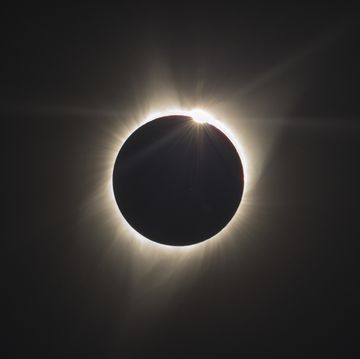Now that the vernal equinox is in the rearview mirror, you're probably ready to roll up your sleeves and get started on all those garden and lawn projects, deep cleaning chores, and (especially!) fun family outdoor outings. But before you go fly a kite, you're going to want to check in with The Old Farmer's Almanac spring forecast for 2025. Whether you're looking to plan a travel adventure in the season of renewal, or this Easter's egg hunt, checking the Almanac's weather predictions just makes good sense. After all, you don't want to put those flower seeds in the ground too early or stash your sweaters away too late.
If you're not familiar with it, the Farmer's Almanac, which was first released way back in 1792, is North America's oldest periodical. Since the days when George Washington was serving his first term as president, it has been a trusted source for everything from data about the moon and stars, to planting charts, recipes, info on holidays, and, most famously, weather forecasts. Ahead, we'll answer all your questions about how its staff predicts meteorological conditions—and what they say we can look forward to this spring (hint: think more wet and wild than dry and dull).
How often are the Farmer's Almanac predictions correct?
The cherished publication provides long-range predictions for each season, rather than daily forecasts, using solar science, climatology, and meteorology. It compares current solar activity and patterns with historical weather statistics, using a methodology based on a formula devised by the man who founded the periodical. Robert B. Thomas believed that sunspots, magnetic storms on the sun's surface, influenced Earth's weather. Today this theory, combined with modern technology and science, helps the Farmer's Almanac correctly predict weather events and trends as much as 80 percent of the time.
What kind of spring is predicted for 2025?
While conditions will of course vary across the United States, according to the Farmer's Almanac much of the country can expect to experience warmer spring temperatures than normal. That's due in part to the higher levels of solar activity we'll be seeing into July. The only exceptions could be regions like central and southern California into the Desert Southwest, southern Florida, and the western half of the Ohio River Valley. However, the mountainous regions of the West should be wary of a May frost following April's warmth, while the Lower Great Lakes may get some late snow.
Speaking of precipitation, most of the U.S. should easily beat the seasonal average in rainfall, except for a dry swath running through the nation's midsection, and a few places like the Pacific Northwest, and northern New England. Unfortunately, these warm, wet conditions could mean an active severe weather season ahead, with everything from thunderstorms and damaging winds to hail and tornadoes predicted for the Deep South.
Will it be a warm spring in 2025?
The Old Farmer's Almanac also helpfully breaks down its long-range forecasts into 18 regions, which gives readers a better idea of spring temperatures specific to their neck of the woods. And thereby helps to answer the eternal, all-important question: can I start planting now?
- Region 1: Northeast
This northern region, which includes Maine, New Hampshire, Vermont, eastern New York, and western Massachusetts, will see temperatures about 3°F above normal in April, with no significant snow in the forecast. - Region 2: Atlantic Corridor
Covering the coastline from Boston, Massachusetts to Richmond, Virginia, the Atlantic Corridor is predicted to score warm weather this spring. The southernmost part of Region 2 in particular could experience temperatures as much as 5°F higher than normal in April. Precipitation will be slightly above average in April and slightly below average in May. - Region 3: Appalachians
A mountainous slice of the eastern U.S. encompassing parts of New York, Pennsylvania, Maryland, Virginia, and western North Carolina, the Appalachians will be somewhat warmer and wetter than usual this spring. - Region 4: Southeast
The Southeast (most of North Carolina, South Carolina, and Georgia) will have average precipitation and temperatures along the coast, but residents inland can expect weather 3°F or 4°F warmer in April and May. - Region 5: Florida
The Sunshine State's northern half will see warmer and wetter conditions this spring, while southern Florida should stay relatively cool and dry. - Region 6: Lower Lakes
Expect the chunk of the country immediately surrounding the lower Great Lakes (including much of Michigan and Illinois, all the way to western New York), to have a warm April and May. Precipitation will be higher than the seasonal average in the east and lower in the west. - Region 7: Ohio Valley
The section of the great Ohio River Valley encompassing much of Kentucky and parts of Illinois and Indiana will experience a drier, cooler April than usual. May will bring higher rainfall and temperatures than normal across the entire region, including southern Ohio and western West Virginia. - Region 8: Deep South
April will offer normal temperatures across the Deep South but May will warm up considerably, with above-average temperatures continuing through summer. It will be rainier (especially in southern Louisiana, Mississippi, and Alabama) all spring. - Region 9: Upper Midwest
Minnesota, Wisconsin's northern half, Michigan's Upper Peninsula, and the Dakota's eastern portion will enjoy temperatures as high as 3°F above average this spring. It will be drier in the Upper Midwest's north, and wetter in the south. - Region 10: Heartland
Encompassing the breadbasket region of Iowa, Missouri, and eastern Kansas and Nebraska, the Heartland will have a warm, dry spring. These conditions are expected to continue through summer. - Region 11: Texas-Oklahoma
April will be cool for this region, with May bringing temperatures 3°F above average. The warm-up will persist through summer. Expect about average precipitation. - Region 12: High Plains
Stretching from Bismarck, North Dakota to Amarillo, Texas, and west into Montana, Wyoming, and Colorado, the U.S. Plains will experience a dry spring in the northern region and a wet one in the south. April temperatures could reach as high as 6°F above average in the north, with periods of dangerous heat possible through the summer months. - Region 13: Intermountain
This massive piece of the mountainous west runs from Spokane, Washington down to Flagstaff, Arizona, and includes all of Idaho, most of Nevada and Utah, as well as western Montana, Wyoming, and Colorado. Rainfall will exceed the seasonal norm, with temperatures 4°F above average in April and 3°F below average in May. - Region 14: Desert Southwest
The arid regions of Arizona and New Mexico, along with bits of California, Nevada, and Texas, won't be quite so dry (and warm) as usual this spring. - Region 15: Pacific Northwest
Spring will be somewhat drier than normal in coastal Washington, Oregon, and northern California, with above-average temperatures in April that will fall below the norm in May. - Region 16: Pacific Southwest
Most of The Golden State can bank on a warmer April followed by a cool May, with temperatures dipping as much as 3°F below average. Precipitation will be below normal in northern California and above normal in the south. - Region 17: Alaska
The Last Frontier will be warmer and wetter than usual this spring. - Region 18: Hawaii
If you're considering a trip to Hawaii this spring, the forecast calls for rainy weather across the state, with warmer temperatures on the Big Island.
Jill Gleeson is a travel journalist and memoirist based in the Appalachian Mountains of western Pennsylvania who has written for websites and publications including Good Housekeeping, Woman’s Day, Country Living, Washingtonian, Gothamist, Canadian Traveller, and EDGE Media Network. Jill is the travel editor for Enchanted Living. Learn more about her journey at gleesonreboots.com.














